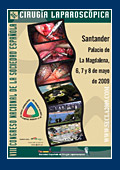Correspondencia:
Pablo Priego Jiménez
C/ Fermín Caballero 26 1º A
16004 Cuenca
667858557
[email protected]
Fuentes Valdés, E. (1), Martín González, M. A. (2), Maldonado Serrano, M. (3): VÍDEOTORACOSCOPIA Y TUMORES NEUROGÉNOS BENIGNOS DE MEDIASTINO.
Seclaendosurgery.com (en línea) 2008, nº 26.
Disponible en Internet. http://www.seclaendosurgery.com/seclan26/articulos/art03.htm
ISSN: 1698-4412
RESUMEN
Generalmente benignos, los tumores neurógenos de mediastino son lesiones que se consideran ideales para resección mediante cirugía torácica videoasistida. Objetivo. Revisar la experiencia obtenida en el Hospital Hermanos Ameijeiras con el tratamiento mínimamente invasivo de estos tumores. Pacientes y métodos. Entre septiembre de 1999 y diciembre de 2007 fueron intervenidos 7 pacientes, todas del sexo femenino, por presentar tumores neurógenos de mediastino posterior. Tres estaban en la cuarta década de la vida, 3 en la sexta y una en la séptima. El promedio de edad fue 47,1 años. La paciente mas joven tenía 34 años y la mayor 63. El tiempo quirúrgico fluctuó entre 40 y 120 minutos (promedio 79,6). En 5 enfermas se emplearon 4 puertos de entrada y 3 en el resto. Resultados. No hubo necesidad de convertir a cirugía convencional ni ocurrieron accidentes quirúrgicos, complicaciones o muertes. Durante el seguimiento entre 6 y 72 meses (promedio 24,4) no se detectaron recidivas del tumor. Conclusiones. La cirugía torácica videoasistida es segura y efectiva en el tratamiento de pacientes con tumores neurógenos del mediastino posterior.
Palabras clave
Schwanoma, neurilemoma, tumor neurógeno, cirugía torácica videoasistida
SUMMARY
Generally benigns, mediastinal neurogenic tumors are considered ideal candidates for resection through video-assisted thoracoscopic surgery. Objective. To review our experience, at Hermanos Ameijeiras Hospital, with minimally invasive surgery on these tumors. Patients and methods. Betwen September 1999 and December 2007 we operated on 7 consecutive female patients with posterior mediastinal neurogenic tumors. Three were in the fourth decade of life, three in the sixth decade and one in the seventh decade. The youngest patient was 34 years old and the oldest 63. Surgical time ranged from 40 minutes to 120 minutes (mean 79,6 minutes). In 5 patients we used 4 ports and 3 ports in 2 patients. Results. There was no need to convert to conventional surgery. There were not surgical accidents, complications or deads. No recurrences of the tumors were documented during the follow up betwen 6 and 72 months (mean 24,4 months). Conclusions. Video-assisted thoracoscopic surgery is safe and reliable in the treatment of patients with mediastinal neurogenic tumors.
Key words
Schwannoma, neurilemoma, neurogenic tumors, video-assisted thoracic surgery
INTRODUCCIÓN
PACIENTES Y MÉTODOS
RESULTADOS
DISCUSIÓN
REFERENCIAS BIBLIOGRÁFICAS
 Sitio Web:
Sitio Web:



